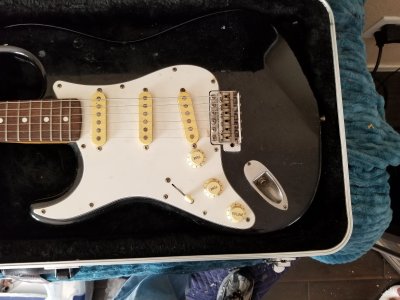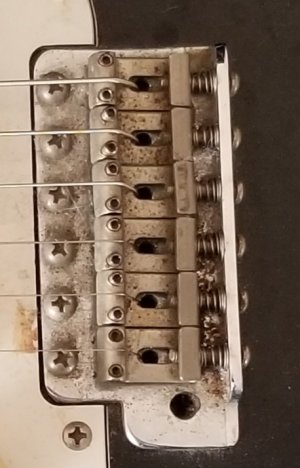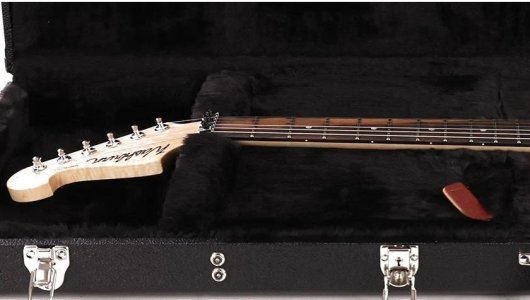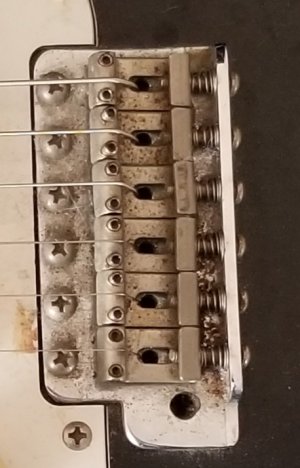FluorideInMyWater
Junior Member
- Messages
- 70
howdy folks.
i need a reaplacement neck b/c the original neck on my 1989 MIJ strat has dented frets. cheaper to get a new neck from warmoth!
I'm debating getting a modern-tiltback neck with a 10-16 compound radius, and putting on new turners.. I"m leaving my old neck intact while i practice fret replacement on cheap-@ss necks, since mine is now considered "vintage" and i don't want to mess it up.
i'm new to the guitar setup and repair world. i've been doing a lot of reading, but i'll probably use incorrect terms, so please feel free to correct me.
the new neck that i'm going to purchase will go on my old MIJ strat, but then i will most likely use it in a new custom build later on. the new guitar will have new modern parts....modern tremelo, possibly floyd rose, modern tuners, new pickups and wiring, etc. so i'm not going to be upgrading the tremelo for this particular project and thread. i'm going to use the existing stock '89 tremelo (see pics. btw this is a left-handed guitar)
so i'm considering a modern tiltback replacement neck because i read that it increases the quality of intonation (?). but i've heard that increases the load on the headstock. i know warmoth uses 2 pieces of wood to create thier gibson replacment necks so they are much stronger than the originals so are much less prone to cracking. i don't know if the strat modern tiltback uses 2 pieces like the gibson tiltback necks. so are the strat replacment modern tiltback necks as strong as a non-tilting neck......or reletively close?
the main reason i'm asking is because i plan to use the tremelo for more 80's type guitar solos.......so i'm going to do some dive-bombing on it and use it a bit more frequently for solos like VH, Rush, Pink Floyd....possibly some metal. i know that a floyd rose would be better suited, but again, that will be for my next project guitar. So will using my existing tremelo with a modern tiltback neck put extra stress on the new neck in a negative way? or would a regular non-tilted neck be better suited for this?
i also have asked this question in other forums that are slow boards so i don't get much feedback. one person did tell me to get locking tuners because it would help keep the guitar in tune better than non-locking ones. thier reasoning is that when you have coils around a regular tuners shaft (rod?...) each time you use the tremelo the string coils will loosen and then tighten back up and re-seat differently causing more frequent need to retune. is he correct or is that just silly? i also have read that some people experience problems with locking tuners breaking the thinner strings and the locking pins on the thinner ones (E & B). perhaps this was on cheaper locking tuners.
So the second question is: if i'm going with a moden-tiltback neck, should i or should i not use locking tuners (using the tremelo posted)
Finally, regarding the fretboard profile, i've heard about compound radius (10 - 16) necks that apparently play faster as you move up the neck into solos. if i'm going to be doing more soloing on this neck would this be a good choice or would it be better to just get a straight 12" radius (or other)? i'm planning on getting a C-shaped neck. not sure if a wizard would be better but that also might put me in jeopardy of snapping the headstock because the neck is thinner and therefore not as strong. (?)
Thanks in advance for you guidence!
i need a reaplacement neck b/c the original neck on my 1989 MIJ strat has dented frets. cheaper to get a new neck from warmoth!
I'm debating getting a modern-tiltback neck with a 10-16 compound radius, and putting on new turners.. I"m leaving my old neck intact while i practice fret replacement on cheap-@ss necks, since mine is now considered "vintage" and i don't want to mess it up.
i'm new to the guitar setup and repair world. i've been doing a lot of reading, but i'll probably use incorrect terms, so please feel free to correct me.
the new neck that i'm going to purchase will go on my old MIJ strat, but then i will most likely use it in a new custom build later on. the new guitar will have new modern parts....modern tremelo, possibly floyd rose, modern tuners, new pickups and wiring, etc. so i'm not going to be upgrading the tremelo for this particular project and thread. i'm going to use the existing stock '89 tremelo (see pics. btw this is a left-handed guitar)
so i'm considering a modern tiltback replacement neck because i read that it increases the quality of intonation (?). but i've heard that increases the load on the headstock. i know warmoth uses 2 pieces of wood to create thier gibson replacment necks so they are much stronger than the originals so are much less prone to cracking. i don't know if the strat modern tiltback uses 2 pieces like the gibson tiltback necks. so are the strat replacment modern tiltback necks as strong as a non-tilting neck......or reletively close?
the main reason i'm asking is because i plan to use the tremelo for more 80's type guitar solos.......so i'm going to do some dive-bombing on it and use it a bit more frequently for solos like VH, Rush, Pink Floyd....possibly some metal. i know that a floyd rose would be better suited, but again, that will be for my next project guitar. So will using my existing tremelo with a modern tiltback neck put extra stress on the new neck in a negative way? or would a regular non-tilted neck be better suited for this?
i also have asked this question in other forums that are slow boards so i don't get much feedback. one person did tell me to get locking tuners because it would help keep the guitar in tune better than non-locking ones. thier reasoning is that when you have coils around a regular tuners shaft (rod?...) each time you use the tremelo the string coils will loosen and then tighten back up and re-seat differently causing more frequent need to retune. is he correct or is that just silly? i also have read that some people experience problems with locking tuners breaking the thinner strings and the locking pins on the thinner ones (E & B). perhaps this was on cheaper locking tuners.
So the second question is: if i'm going with a moden-tiltback neck, should i or should i not use locking tuners (using the tremelo posted)
Finally, regarding the fretboard profile, i've heard about compound radius (10 - 16) necks that apparently play faster as you move up the neck into solos. if i'm going to be doing more soloing on this neck would this be a good choice or would it be better to just get a straight 12" radius (or other)? i'm planning on getting a C-shaped neck. not sure if a wizard would be better but that also might put me in jeopardy of snapping the headstock because the neck is thinner and therefore not as strong. (?)
Thanks in advance for you guidence!







